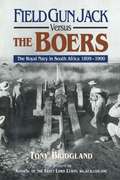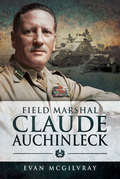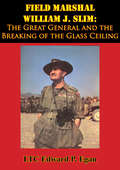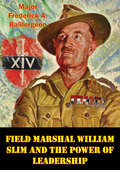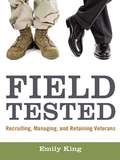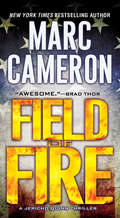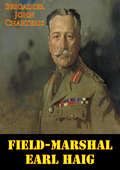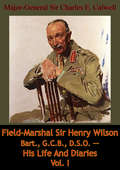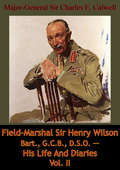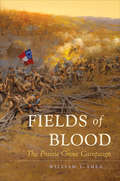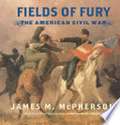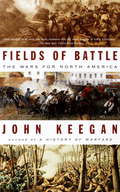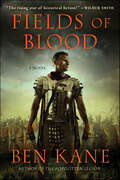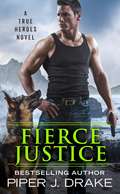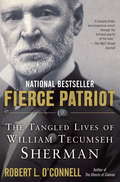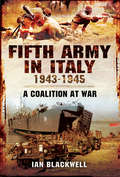- Table View
- List View
Field Gun Jack Versus the Boers: The Royal Navy in South Africa, 1899–1900
by Tony BridglandWar broke out in 1899 between the British and South African settlers of Dutch descent, the Boers, or Afrikaners as they are usually called today. Despite previous clashes, the British seriously underestimated their opponents. Although dressed in battered civilian clothes and made up entirely of volunteers, Boer troops were all mounted on horses and had very up-to-date German rifles.An even more unpleasant surprise than the mounted riflemen were the Boer artillery units. They were the only Boer troops to wear uniforms, were organized on a full-time basis, and were equipped with excellent German field pieces. The British artillery soon found itself out-gunned and out-ranged.Some British officers, however, were capable of adapting to the new conditions in South Africa. Royal Naval vessels anchored off the Cape had powerful, long-range cannons. It was decided to try bringing these guns ashore and mounting them on improvised carriages for field use. Naval infantry brigades had served in some previous campaigns, and proved capable of accompanying the army as gun crews, their straw hats and naval leggings identifiable in many wartime photographs.Although they were depicted in many wartime drawings and photographs, no serious study of the naval artillery has ever been done. Tony Bridgland has spent many years researching the topic and has produced a study of the technical problems involved in this unique operation, as well as a colourful narrative of naval personnel pressed into hazardous service far from the sea.
Field Marshal Claude Auchinleck
by Evan McGilvrayThis military biography explores the life and service of a British Indian Army officer who served with distinction across both world wars.During the First World War, Field Marshal Claude Auchinleck was awarded a Distinguished Service Order for his efforts in Egypt and the Mesopotamian Campaign. Afterward, he aided the pacification of the Northwest Frontier, now Pakistan. In the Second World War he briefly led a division in the ill-fated Norway campaign before being appointed Commander-in-Chief, India. Auchinleck is best remembered for his time as Commander-in-Chief of the Middle East Theatre, where he halted Rommel at the First Battle of El Alamein. He then resumed command in India, where his leadership was vital to success in Burma. In the post-war years, he planned and oversaw the Partition of India and the British withdrawal.In this extensively researched biography, historian Evan McGilvray examines Auchinleck’s long career as well as the transformations of the British military and the Empire itself.
Field Marshal Slim - Theoretical Thinking And The Impact Of Theory On Campaign Planning
by Major Shawn P. SteeleField Marshall Viscount Slim holds a special place in modern military history. He soundly defeated the Imperial Japanese Army in Burma in 1945, retaking the strategically important Burma Road, and safeguarding the Chinese Theater from sure culmination. By all accounts, Slim is a military genius, having achieved this notable victory even after the Japanese 15th Army pushed Allied troops all the way back to India. The historical records attribute Slim's success to his superior ability to lead soldiers in combat, but they tell only half the story. By tracing Slim's implicit process of theoretical thinking, using an observe, interpret, hypothesize, test, and prescribe action framework, this story demonstrates that Slim's genius came from a combination of his abilities to lead and think theoretically. Specifically, in the case of Slim, his ability to think theoretically afforded him the opportunity to develop a new operational approach-a paradigm shift of sorts-and his leadership made it possible to motivate his men to employ that approach. The author asserts that it is the presence of these two abilities in a single man that make him a superior military commander.
Field Marshal William J. Slim: The Great General and the Breaking of the Glass Ceiling
by LTC Edward P. EganField Marshal William J. Slim is considered by many historians to be one of the finest generals of World War II. His accomplishments were truly extraordinary. He commanded a polyglot army, consisting of six different nationalities speaking eight different languages, that fought in some of the most inhospitable, disease-ridden country in the world against the war's toughest opponent, the Japanese. In March 1942, he assumed command of a British-Indian force in Burma half way through the longest retreat in the British Army's history. Even though he was unable to reverse the disaster, he kept his force intact and led it to safety. Over the next three and one half years, despite very limited resources and several inept senior commanders, he rebuilt his force into an army that was able to inflict on the Japanese their greatest land defeat of World War II. In the process, he conducted four of the most classic operational campaigns of the war--the battle of the Second Arakan; the battles of Kohima and Imphal; the capture of Mandalay and Meiktila; and the pursuit to Rangoon. Throughout his career, but especially during World War II, Slim met all the criteria for a great general and strategic leader as set forth in Lord Wavell's Generals and Generalship. Despite these great accomplishments, Slim ran into several "glass ceilings" during World War II. Twice he was relieved of command, once immediately after his greatest battlefield victory. This study examines Field Marshal Slim's leadership. It takes a brief look at his biography, then compares him against Wavell's standards for generalship by highlighting events from his career that illustrate each standard. Finally, it addresses the issue of the "glass ceiling"--what it is, the events surrounding Slim's encounters with it, and how Slim was able to overcome it. The intent is to show that Slim was not only a great World War II general, but is still a model of leadership worthy of study by the U.S. Army.
Field Marshal William Slim And The Power Of Leadership
by Major Frederick A. BaillergeonOn 15 January 1942 the Japanese invaded Burma. Within months, the Japanese occupied the country and forced the Allied forces to conduct a brutal retreat into neighboring India. During the next three and one half years, both forces continued to fight in a campaign with the Allied forces retaking Burma in May 1945. One of the principle figures in this turnaround of the Allied Force was Field Marshal William Slim. During the Burma Campaign Slim served in several key leadership positions culminating as the 14 Army Commander. This focus of this study is to determine the role Slim played in the reconquest of Burma. Specifically, how did Field Marshal William Slim's organizational leadership actions (as defined in the U.S. Army leadership manual, FM 22-100) while serving as the 14 Army Commander, contribute to the Allies reconquest of Burma during World War II? It is hoped that the findings of this study will be of value to leaders of all levels currently fighting the Global War on Terrorism.
Field Marshal the Earl of Cavan: Soldier and Fox Hunter
by Michael SeniorField Marshal Lord Cavan (1865-1946) was one of the most distinguished commanders of the modern British army, but he divided opinion among his contemporaries. Some senior soldiers were disdainful. Field Marshal Sir Henry Wilson described him as ‘ignorant, pompous and vain’ and Brigadier General Sir James Edward Edmonds commented that Cavan ‘was bone from the neck upwards’. Yet many of Cavan’s subordinates praised him, saying ‘I had never seen Lord Cavan before and I was filled with admiration by the calm and quiet self-confidence of his manner’ and ‘Our new General, Lord Cavan, is simply A1 and the whole show runs like a well-oiled machine.’ So what were the real qualities and achievements of this remarkable but hitherto neglected officer who in a long career served in the Boer War and the First World War and then presided over the post-war reduction of the British army? Michael Senior, in the first full biography of Cavan, assesses him as a leader, a corps commander and an administrator, and places him among the front rank of the soldiers of his generation. He also explores Cavan’s personal life, his personality and how his aristocratic background, his wealth and his love of fox hunting affected his conduct in both war and peace.
Field Tested: Recruiting, Managing, and Retaining Veterans
by Emily KingVeterans are a tremendous source of untapped talent and come with a wealth of skills and experience beyond those of typical civilian employees. Field Tested gives readers the insight and tools they need to recruit and retain veterans, and to maximize their value in any organization. A must-read for leaders, managers, and human resources professionals across industries, Field Tested uncovers key cultural differences between the military and civilian workplace, and reveals how these differences can affect employee performance, satisfaction, and retention. Complete with real-world examples, practical models, and savvy advice, this book shows readers how to: ò Attract and interview veterans ò On-board them quickly and effectively ò Position them for success ò Ensure a smooth cultural transition ò Manage performance ò Help them develop lasting careers. Smart companies that hire veterans owe it to themselves and their employees to under stand the unique considerations involved. This one-of-a-kind guide reveals how to make the most of AmericaÆs top talent.
Field of Fire (A Jericho Quinn Thriller #7)
by Marc CameronAn explosive Jericho Quinn thriller from the New York Times bestselling author of Brute Force, Stone Cross, and Tom Clancy Code of Honor. The first target is Dallas, Texas. Then, Los Angeles. A deadly nerve gas called New Archangel has been unleashed, claiming innocent lives, spreading nationwide panic, and fueling global fears of yet another attack. In the icy reaches of rural Alaska, special agent Jericho Quinn is enlisted to hunt down the man who created the bioweapon—a brilliant Russian scientist who is trying to defect and hiding in the Alaskan wilderness. But time is running out. The scientist is beginning to lose his mind to dementia. If Quinn doesn&’t find him before the Russians do, the entire western seaboard and beyond will feel the wrath of New Archangel—and darkness will fall upon the earth.Praise for the novels of Marc Cameron &“Blistering reads . . . Cameron&’s books are riveting page-turners.&”—Mark Greaney, #1 New York Times bestselling author &“A double-barreled blast of action, narrative, and impossible-to-fake authenticity with a great sense of place and a terrific protagonist.&”—C. J. Box, #1 New York Times bestselling author &“One of the hottest new authors in the thriller genre.&”—Brad Thor, #1 New York Times bestselling author &“Fascinating characters with action off-the-charts. Masterful.&”—Steve Berry, New York Times bestselling author &“Action-packed, over-the-top . . . Quinn makes a formidable warrior readers will want to see more of.&” —Publishers Weekly
Field of Fire (Seal Team Seven #19)
by Keith DouglassLieutenant Commander Blake Murdock and five members of Seal Team Seven are assigned to back up the CIA on a covert operation in Syria. Their mission: destroy the laboratory housing an electromagnetic pulse (EMP) bomb capable of rendering all electronic components within a hundred-mile radius inoperative. But just when the SEALs think they've been successful, an EMP is detonated just off the coast of Haifa, Israel, disabling the entire city. As Israel's military defends its land from Syrian invasion, Seal Team Seven must enter the fray - and rescue ten American college students trapped in the chaos.
Field-Marshal Earl Haig
by Colonel John Buchan Brigadier John CharterisIncludes 30 maps, plans and illustrations.A detailed personal account of Earl Haig, the man and his principle campaigns, by his closest colleague and confidante. The renowned novelist Buchan, who served under Chateris during the First World War, provides a foreword.“General Charteris had the privilege of serving with Lord Haig in India and at Aldershot, and for the whole of the Great War with the exception of the last two months. During the Battle of the Somme I had the privilege of serving under General Charteris. When, in 1921, the Official History was taking shape, Sir J. E. Edmonds asked Lord Haig whom he would like to go through it on his behalf, with special reference to the work of the I Corps, the answer was: “Send it to Charteris. He knows as much about it as I do.”This book is therefore a study of Lord Haig’s career by one who was himself a sharer in its most momentous stages. It is also a study of a famous soldier by one who brings to the task not only a knowledge of war, but the understanding born of a deep affection. A great man, especially a great man of action, is apt to appear before the world as a combination of abstract powers and virtues, impressive like a statue set up in some public place, but a little remote from our common life...Future historians will discuss every detail of his campaigns, and every aspect of his genius. But in the meantime the world has cause to be grateful, I think, to General Charteris for providing these mémoires pour servir —a personal narrative of how Lord Haig appeared to a colleague and a friend.”-Foreword.“The most competent and authoritative biography of Haig published to date, written by one who was closely associated with him. The book throws much light on Allied strategy as well as on the problem of the high command.”- William L. Langer – Foreign Affairs magazine
Field-Marshal Sir Henry Wilson Bart., G.C.B., D.S.O. — His Life And Diaries Vol. I (Field-Marshal Sir Henry Wilson Bart., G.C.B., D.S.O. — His Life And Diaries #1)
by Marshal Ferdinand Foch Major-General Sir Charles E. Calwellthe First World War, who was a passionate "Westerner" and advocate of the Anglo-French alliance. Major-General C. E. Callwell recounts the story of the outspoken, opinionated and well connected Field Marshal using extensive quotes from his diary, often dripping with acerbic wit, in the greatest of detail."Field Marshal Sir Henry Wilson, an Irishman who in June 1922 was assassinated on his doorstep in London by Irish republicans, was one of the most controversial British soldiers of that age. Before 1914 he did much to secure the Anglo-French alliance and was responsible for the planning which saw the British Expeditionary Force successfully despatched to France after the outbreak of war with Germany. A passionate Irish unionist, he gained a reputation as an intensely 'political' soldier, especially during the 'Curragh crisis' of 1914 when some officers resigned their commissions rather than coerce Ulster unionists into a Home Rule Ireland. During the war he played a major role in Anglo-French liaison, and ended up as Chief of the Imperial General Staff, professional head of the army, a post he held until February 1922. After Wilson retired from the army, he became an MP and was chief security adviser to the new Northern Ireland government. As such, he became a target for nationalist Irish militants, being identified with the security policies of the Belfast regime, though wrongly with Protestant sectarian attacks on Catholics. He is remembered today in unionist Northern Ireland as a kind of founding martyr for the state. Wilson's reputation was ruined in 1927 with the publication of an official biography, which quoted extensively and injudiciously from his entertaining, indiscreet, and wildly opinionated diaries, giving the impression that he was some sort of Machiavellian monster."-Professor Keith Jeffrey.
Field-Marshal Sir Henry Wilson Bart., G.C.B., D.S.O. — His Life And Diaries Vol. II (Field-Marshal Sir Henry Wilson Bart., G.C.B., D.S.O. — His Life And Diaries #2)
by Marshal Ferdinand Foch Major-General Sir Charles E. CalwellThese two volumes form the official biography of Sir Henry Wilson, a key figure in the British Army during the First World War, who was a passionate "Westerner" and advocate of the Anglo-French alliance. Major-General C. E. Callwell recounts the story of the outspoken, opinionated and well connected Field Marshal using extensive quotes from his diary, often dripping with acerbic wit, in the greatest of detail."Field Marshal Sir Henry Wilson, an Irishman who in June 1922 was assassinated on his doorstep in London by Irish republicans, was one of the most controversial British soldiers of that age. Before 1914 he did much to secure the Anglo-French alliance and was responsible for the planning which saw the British Expeditionary Force successfully despatched to France after the outbreak of war with Germany. A passionate Irish unionist, he gained a reputation as an intensely 'political' soldier, especially during the 'Curragh crisis' of 1914 when some officers resigned their commissions rather than coerce Ulster unionists into a Home Rule Ireland. During the war he played a major role in Anglo-French liaison, and ended up as Chief of the Imperial General Staff, professional head of the army, a post he held until February 1922. After Wilson retired from the army, he became an MP and was chief security adviser to the new Northern Ireland government. As such, he became a target for nationalist Irish militants, being identified with the security policies of the Belfast regime, though wrongly with Protestant sectarian attacks on Catholics. He is remembered today in unionist Northern Ireland as a kind of founding martyr for the state. Wilson's reputation was ruined in 1927 with the publication of an official biography, which quoted extensively and injudiciously from his entertaining, indiscreet, and wildly opinionated diaries, giving the impression that he was some sort of Machiavellian monster."-Professor Keith Jeffrey.
Fields Of Blood
by William L. SheaWilliam Shea offers a gripping narrative of the events surrounding Prairie Grove, Arkansas, one of the great unsung battles of the Civil War that effectively ended Confederate offensive operations west of the Mississippi River. Shea provides a colorful account of a grueling campaign that lasted five months and covered hundreds of miles of rugged Ozark terrain. In a fascinating analysis of the personal, geographical, and strategic elements that led to the fateful clash in northwest Arkansas, he describes a campaign notable for rapid marching, bold movements, hard fighting, and the most remarkable raid of the Civil War.
Fields Of Fury: The American Civil War
by James M. McPhersonPulitzer Prize award-winning historian James M. McPherson has written for young readers a stirring account of the greatest conflict to happen on our nation's soil, the Civil War, bringing to life the tragic struggle that divided not only a nation, but also friends and family. <p><p> From the initial Confederate attack on Fort Sumter, to the devastating loss of life at Shiloh as Ulysses S. Grant led the Union to unexpected victory, to the brilliance of Stonewall Jackson's campaign at Shenandoah, to General Pickett's famous charge at Gettysburg, to the Union's triumph at Appo-mattox Court House, Fields of Fury details the war that helped shape us as a nation. Also included are personal anecdotes from the soldiers at the battlefront and the civilians at home, as well as profiles of historical luminaries such as Robert E. Lee, Abraham Lincoln, Jefferson Davis, and Ulysses S. Grant. McPherson also explores the varied roles that women played during the war, healthcare on the battlefield, and the demise of slavery. McPherson's narrative is highlighted with black-and-white photographs taken by Civil War photographers Mathew Brady and Timothy O'Sullivan, period oil paintings, and key campaign and battlefield maps, that make Fields of Fury the consummate book on the American Civil War for kids.
Fields of Battle
by John KeeganAt once a grand tour of the battlefields of North America and an unabashedly personal tribute to the military prowess of an essentially unwarlike people, Fields of Battle spans more than two centuries and the expanse of a continent to show how the immense spaces of North America shaped the wars that were fought on its soil. of photos.
Fields of Battle: Pearl Harbor, the Rose Bowl, and the Boys Who Went to War
by Brian CurtisA riveting story of football, wartime, and boys becoming men—from facing off in the 1942 Rose Bowl to serving together in WWII.In the wake of the bombing of Pearl Harbor, the 1942 Rose Bowl was moved from Pasadena to Durham, North Carolina, out of fear of Japanese attacks on the West Coast. Duke University faced off against underdog Oregon State College, with both teams preparing for a grueling fight on the football field while their thoughts drifted to the battlefields they would soon encounter.On New Year’s Day, the teams played one of the most unforgettable games in history. Shortly afterward, many of the players and coaches entered the military and would quickly become brothers on the battlefield. Scattered around the globe, the lives of Rose Bowl participants would intersect in surprising ways, as they served in Iwo Jima and Normandy, Guadalcanal and the Battle of the Bulge. In one powerful encounter, OSC’s Frank Parker saved the life of Duke’s Charles Haynes in Italy. And one OSC player, Jack Yoshihara, a Japanese-American, never had the chance to play in the game or serve his country, as he was sent to an internment camp in Idaho.In Fields of Battle, Brian Curtis sheds light on a little-known slice of American history with an intimate account of the teamwork, grit, and determination that took these men onto the gridiron and into combat.
Fields of Blood: A Novel (Hannibal #2)
by Ben KaneHannibal's campaign to defeat Rome continues. Having brought his army safely over the Alps in winter, he now marches south to confront the enemy. With him is a young soldier, Hanno. Like his general, Hanno burns to vanquish Rome. Never has the possibility seemed so likely. Facing Hanno is his former friend, Quintus, whom Hanno met while in Roman captivity. A bitter quarrel with his father led Quintus to join the Roman infantry under an assumed name. Among his legionaries, he finds that his enemies are not just the Carthaginians, but men of his own side. A stealthy game of cat and mouse is being played, with Hannibal seeking to fight, and Rome's generals avoiding battle. But battle cannot be delayed for much longer. Eventually, the two armies meet under a fierce summer sun in August in the south of Italy. The place is Cannae-the fields of blood. The encounter will go down in history as one of the bloodiest battles ever fought, a battle in which Hanno and Quintus know they must fight as never before-just to stay alive.
Fields of Combat: Understanding PTSD among Veterans of Iraq and Afghanistan (The Culture and Politics of Health Care Work)
by Erin P. Finley"If you consider Iraq—like I do, probably twenty-nine out of thirty days—to be the pinnacle of your life, then where do you go from there? And I'm sure that a lot of veterans feel that way. To them, that was it. That was everything. So now what? They have to find something meaningful and purposeful.""When I got back from Afghanistan, there was not even so much as a briefing that said, 'Let us know if you're having problems.' There wasn't so much as a phone number. There was literally nothing.""I knew it was crazy. I was thinking, the guy on the roof's either a sniper or he's going to radio ahead. And then I thought, this is San Antonio. There's not snipers on the roof, nobody's going to blow me up here.""Whenever I look at people back here at home, I know what they're going to look like dead. I know what they look like with their brains blown out or jaws blown off or eyes pulled out. When I look at somebody I see that, to this day."—Voices of veterans interviewed in Fields of CombatFor many of the 1.6 million U.S. service members who have served in Iraq and Afghanistan since 2001, the trip home is only the beginning of a longer journey. Many undergo an awkward period of readjustment to civilian life after long deployments. Some veterans may find themselves drinking too much, unable to sleep or waking from unspeakable dreams, lashing out at friends and loved ones. Over time, some will struggle so profoundly that they eventually are diagnosed with post-traumatic stress Disorder (PTSD).Both heartbreaking and hopeful, Fields of Combat tells the story of how American veterans and their families navigate the return home. Following a group of veterans and their personal stories of war, trauma, and recovery, Erin P. Finley illustrates the devastating impact PTSD can have on veterans and their families. Finley sensitively explores issues of substance abuse, failed relationships, domestic violence, and even suicide and also challenges popular ideas of PTSD as incurable and permanently debilitating. Drawing on rich, often searing ethnographic material, Finley examines the cultural, political, and historical influences that shape individual experiences of PTSD and how its sufferers are perceived by the military, medical personnel, and society at large. Despite widespread media coverage and public controversy over the military's response to wounded and traumatized service members, debate continues over how best to provide treatment and compensation for service-related disabilities. Meanwhile, new and highly effective treatments are revolutionizing how the Department of Veterans Affairs (VA) provides trauma care, redefining the way PTSD itself is understood in the process. Carefully and compassionately untangling each of these conflicts, Fields of Combat reveals the very real implications they have for veterans living with PTSD and offers recommendations to improve how we care for this vulnerable but resilient population.
Fields of Fire
by Terry CoppWith Fields of Fire, Terry Copp challenges the conventional view that the Canadian contribution to the Battle of Normandy was a "failure" - that the allies won only through the use of brute force, and that the Canadian soldiers and commanding officers were essentially incompetent. His detailed and impeccably researched analysis of what actually happened on the battlefield portrays a flexible, innovative army that made a major, and successful, contribution to the defeat of the German forces in just seventy-six days.Challenging both existing interpretations of the campaign and current approaches to military history, Copp examines the Battle of Normandy, tracking the soldiers over the battlefield terrain and providing an account of each operation carried out by the Canadian army. In so doing, he illustrates the valour, skill, and commitment of the Allied citizen-soldier in the face of a well-entrenched and well-equipped enemy army.This new edition of Copp's best-selling, award-winning history includes a new introduction that examines the strategic background of the Battle of Normandy.
Fierce Ambition: The Life and Legend of War Correspondent Maggie Higgins
by Jennet Conant“Mesmerizing.… Conant’s book has brought [Maggie Higgins] back to life.” —Andrew Nagorski, Wall Street Journal A spirited portrait of twentieth-century war correspondent Maggie Higgins and her tenacious fight to the top in a male-dominated profession. Marguerite Higgins was both the scourge and envy of the journalistic world. A longtime reporter for the New York Herald Tribune, she first catapulted to fame with her dramatic account of the liberation of Dachau at the end of World War II. Brash, beautiful, ruthlessly competitive, and sexually adventurous, she forced her way to the front despite being told the combat zone was no place for a woman. Her headline-making exploits earned her a reputation for bravery bordering on recklessness and accusations of “advancing on her back,” trading sexual favors for scoops. While the Herald Tribune exploited her feminine appeal—regularly featuring the photogenic "girl reporter" on its front pages—it was Maggie’s dogged determination, talent for breaking news, and unwavering ambition that brought her success from one war zone to another. Her notoriety soared during the Cold War, and her daring dispatches from Korea garnered a Pulitzer Prize for foreign correspondence—the first granted to a woman for frontline reporting—with the citation noting the unusual dangers and difficulties she faced because of her sex. A star reporter, she became part of the Kennedy brothers’ Washington circle, though her personal alliances and politics provoked bitter feuds with male rivals, who vilified her until her untimely death. Drawing on new and extensive research, including never-before-published correspondence and interviews with Maggie’s colleagues, lovers, and soldiers and generals who knew her in the field, journalist and historian Jennet Conant restores Maggie’s rightful place in history as a woman who paved the way for the next generation of journalists, and one of the greatest war correspondents of her time.
Fierce Justice (True Heroes #5)
by Piper J. DrakeReal heroes aren't born, they're madeK9 handler Arin Siri doesn't like taking orders, and she works best when it's just her and her dog King out in the field. But when she discovers a wounded soldier of fortune during a Search and Protect mission, she has no choice but to get him to safety. The last time she and the roguish, sexy Jason Landon tangled, they were on opposite sides of the conflict, but this time, he's claiming to need her help.When Jason wakes up in a hospital on Hawaii's Big Island, he's shocked to discover Arin guarding him. She's the last person he expected to see, but she's also the only person who can help him bring down a kidnapping ring. As they draw closer to danger-and to each other-they must race against the clock to discover who the kidnappers are working for, or risk becoming collateral damage themselves.
Fierce Patriot: The Tangled Lives of William Tecumseh Sherman
by Robert L. O'ConnellWilliam Tecumseh Sherman was more than just one of our greatest generals. Fierce Patriot is a bold, revisionist portrait of how this iconic and enigmatic figure exerted an outsize impact on the American landscape--and the American character. America's first "celebrity" general, William Tecumseh Sherman was a man of many faces. Some of them were exalted in the public eye. Others were known only to intimates--his family, friends and lovers, and the soldiers under his command. In this rich and layered portrait, Robert L. O'Connell captures the man in full for the first time. From his early exploits in Florida, to his role in California at the start of the Gold Rush, through his brilliant but tempestuous generalship during the Civil War, and to his postwar career as a key player in the building of the transcontinental railroad, Sherman was, as O'Connell puts it, the "human embodiment of Manifest Destiny." Here is Sherman the military strategist of genius, a master of logistics whose uncanny grasp of terrain and brilliant sense of timing always seemed to land him in the right place at the most opportune moments. O'Connell shows how Sherman's creation of an agile, improvisational fighting force--the Army of the West--helped turn the tide of the Civil War and laid the foundation for modern U.S. ground forces. Then there is "Uncle Billy," Sherman's public persona, a charismatic hero to his troops and quotable catnip to the newspaper writers of his day. Here, too, is the private Sherman. He was born into one powerhouse family--his grandfather signed the Declaration of Independence--and was adopted into another. His foster father, Thomas Ewing, was an influential politician and cabinet member who helped provide key opportunities for Sherman throughout his career. But Sherman's fraught relationship with Ewing, coupled with his appetite for women, parties, and the high life of the New York theater, certainly complicated his already turbulent marriage to his foster sister Ellen, a relationship O'Connell likens to a mix of "gunpowder and gasoline"--altogether a family triangle that might have sprung from the pages of a Victorian novel. As he peels away the layers of the Sherman persona, O'Connell dispels a number of common misperceptions about his subject. He sheds new light on Sherman's relationship with Ulysses S. Grant, and also on his struggle against Nathan Bedford Forrest and the insurgency that was the other half of the Civil War along the Mississippi. Later he reveals Sherman's fabled march from Atlanta to the sea not as a campaign of unmitigated destruction, as it is often portrayed, but the careful execution of a necessary piece of strategy calculated to scare the South back into the Union. O'Connell's Sherman is no Attila, but a complicated soldier/statesman--perhaps the quintessential nineteenth-century American. Warrior, family man, American icon, William Tecumseh Sherman has finally found a biographer worthy of his protean gifts. A masterful character study whose myriad insights are leavened with its author's trademark wit, Fierce Patriot will stand as the essential book on Sherman for decades to come.
Fierce Valor: The True Story of Ronald Speirs and his Band of Brothers
by Jared Frederick Erik DorrFans of Stephen E. Ambrose&’s Band of Brothers will be drawn to this complex portrait of the controversial Ronald Speirs, an iconic commander of Easy Company during World War II, whose ferocious courage in three foreign conflicts was matched by his devotion to duty and the bittersweet passions of wartime romance. His comrades called him &“Killer.&” Of the elite paratroopers who served in the venerated &“Band of Brothers&” during World War II, none were more enigmatic than Ronald Speirs. Rumored to have gunned down enemy prisoners and even one of his own disobedient sergeants, Speirs&’ became a foxhole legend amongst his troops. But who was the real Lieutenant Speirs? In Fierce Valor, historians Jared Frederick and Erik Dorr unveil the full story of Easy Company&’s longest-serving commander for the first time. Tested by trials of extreme training, military rivalry, and lost love, Speirs&’s international odyssey begins as an immigrant child in Prohibition-era Boston, continues through the bloody campaigns in France, Holland, and Germany, and sheds light on his lesser known exploits in Korea, the Cold War, and embattled Laos. Packed with groundbreaking research, Fierce Valor unveils a compelling portrait of an officer defined by boldness on the battlefield and a telling reminder that few soldiers escape the power of their own pasts.
Fifteen Rounds a Minute: The Grenadiers at War, August to December 1914, Edited from Diaries and Letters of Major ‘Ma’ Jeffreys and Others
by Michael CrasterThis book, originally published in 1976, is an account of the first five months of the First World War, as seen by members of a battalion of the Grenadier Guards and told in their own words and a classic of military writing. Contrary to the popular view of that war, this was a period of movement as the Allies sought first to block the German's apparently irresistible march on Paris, then to push them back to the Belgian border until finally both sides engaged in the 'Race for the Sea' in an attempt to find and exploit the open flank. It was a phase that included the retreat from Mons, the Battles of the Marne and the Aisne and finally and most devastatingly the First Battle of Ypres.The book is based on the diary that was kept by the Battalion Second in Command, Major George (subsequently General the Lord) Jeffreys, known to everyone as 'Ma'. Described by Harold Macmillan as one of the greatest of commanding officers, he was one of only three officers who went to war with the Battalion in August 1914 who survived with it to the end of the year. Supplemented on occasion by the letters and diaries of his brother officers and others, it provides a very complete picture of those turbulent days.
Fifth Army in Italy, 1943–1945: A Coalition at War
by Ian BlackwellA history of the Allied coalition in Italy during World War II.The US Fifth Army first saw action during the Salerno Landings in September 1943. While commanded by US Lieutenant General Mark Clark, from the outset one of its two Corps was the X (British) Corps; the other V1 (US) Corps.The multi-national composition of Fifth Army is demonstrated by the French Expeditionary Corps, the Brazilian Expeditionary Force, the South African Armoured Division, the Italian Co-Belligerent forces, formations from the New Zealand Corps and the 4th Indian Division.Clark’s Fifth Army was itself part of the Fifteenth Army Group, commanded by Field Marshal Alexander. Alexander’s light and diplomatic touch oiled the wheels of this uneasy arrangement but inevitably there were tensions and disagreements that threatened success.The low priority accorded to Italy as compared with OVERLORD and NW Europe did not help matters. Seen as a backwater, crack units were taken away and insufficient resources allocated to the Italian Campaign. This combined with the tenacity of the Germans, the difficult terrain and the harsh climate caused real problems. Allied morale was at times particularly brittle and desertion rates worryingly high.This superbly researched book objectively examines the performance of Fifth Army against this complex and troublesome backdrop. The author’s findings make for authoritative and fascinating reading and give food for thought about multinational cooperation in more recent conflicts.
